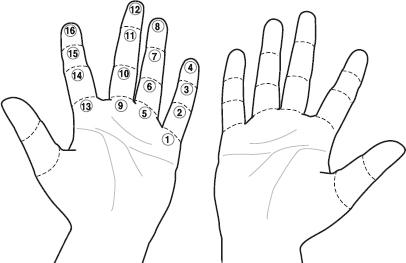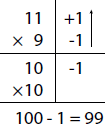Multiplication
In This Chapter
![]()
- Getting “hands-on” with finger multiplication
- Tricks you can use when multiplying by 11
- How the base method can help you simplify multiplication problems
- Multiplying numbers that aren’t close to a base
- Using the vertically and crosswise method to multiply numbers
You may wonder why I’m beginning with multiplication. After all, wouldn’t it be easier to start with addition or subtraction? It’s that sense of dread you may feel about jumping into multiplication that makes me want to talk to you about it right away. Speed math is especially impressive for multiplication problems; the methods are so simple, you’ll actually enjoy doing it!
In this chapter, I talk about the many ways you can quickly and easily solve multiplication problems, including finger multiplication, a special technique when multiplying numbers by 11, the base method, and the vertically and crosswise method.
One of the most daunting problems for students—and adults—is getting their times table correct. In different countries, math teachers rely on different methods to make this daunting task easier. The most popular method is rote memorization. Some also rely on flash cards or visual representation of the figures.
I want to show you a way to do multiplication tables that only requires your hands—it’s called finger multiplication. In my experience, people find finger multiplication very enjoyable, as it’s very tactile and gives instant answers.
But how does finger multiplication work? If you open up your palms and look at your fingers closely, you’ll note that each finger (excluding the thumb) can be divided into four parts.
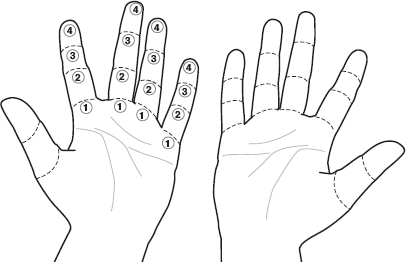
You can use these finger divides or finger joints on both your hands to do basic calculations for your multiplication tables.
Note that on one hand you can actually count up to 16, as you can see in the following image.
Now that you know how the finger joints play a role, let me take you through how to do the multiplication with different times tables.
The 2 Times Table
To do finger multiplication for the 2 times table, group the finger joints in twos and skip count by those to get your answers.
Say you have to solve 2 × 1. Using finger multiplication, all you need to do is count in twos once. This gives you the answer of 2.
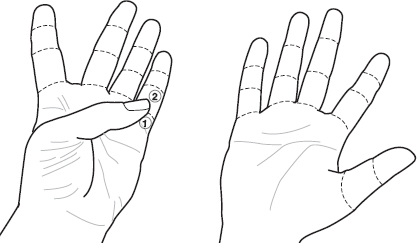
For 2 × 5, you count in twos five times to get 10. Because you know there are two groups 2 on each hand, you can skip count in twos and reach 10.
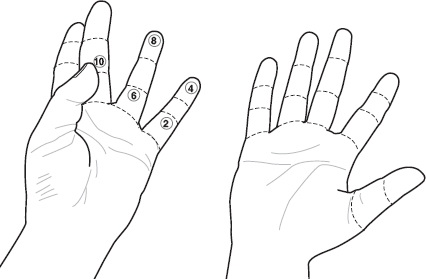
And 2 × 8 is equal to 16.
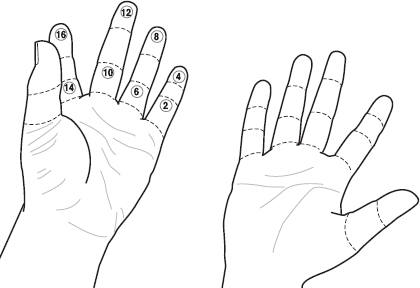
You can use the same process on the fingers on your other hand to do 2 × 9 and above.
What you did for the 2 times table can be extended to the 3 times table as well. You use the joints to make groups of three and skip count by those to arrive at your answer.
For example, to get 3 × 1, you count by threes once, which tells you the answer is 3.
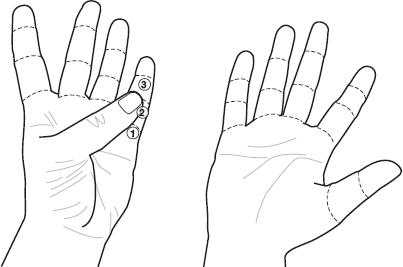
3 × 2 means you count in threes twice. This gives you an answer of 6.
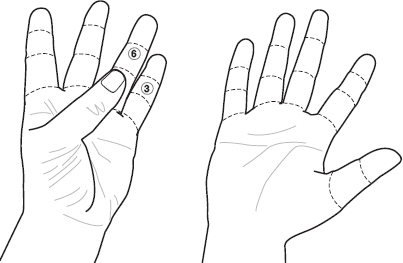
Similarly, for 3 × 3, you count in threes three times to get your answer of 9.
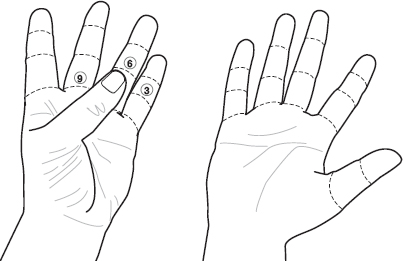
For 3 × 6 and upward, you can use your other hand for your calculations.
QUICK TIP
If you’d like to have the 3 times table spread more evenly on your hands, consider counting only the first three joints on each finger and thumb.
The 4 Times Table
As you know, each finger has four parts, so the 4 times table is the easiest finger multiplication you can do.
To do 4 × 1, you simply hold out the little finger. Because there are four on one finger, you have your answer: 4.
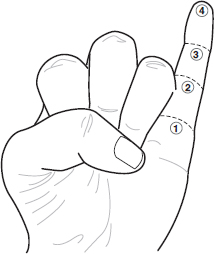
Similarly, for 4 × 2, you hold out two fingers. You can count in fours twice on each finger, or you can just simply think of how there are four joints on each and quickly get your answer, which is 8.
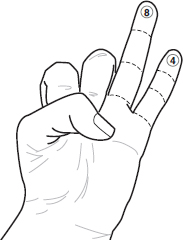
4 × 4 requires you lift four fingers to get 16.
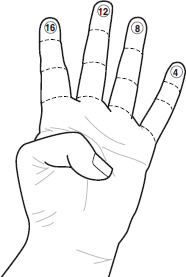
To understand the universal times tables in finger multiplication, you already need to know your times tables up to 5. This method can help you do 6 times, 7 times, 8 times, 9 times, and 10 times tables.
To do the multiplication for these tables, you mentally number the fingers of both your hands from 10 to 6:
Thumb: 10
Index finger: 9
Middle finger: 8
Ring finger: 7
Little finger: 6
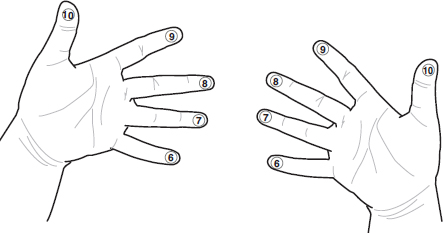
QUICK TIP
If you have trouble envisioning the numbers on your own fingers, feel free to use a pen to label them. Just make sure you don’t wear them on your hands when taking a test!
Now let’s try a problem, 9 × 8. Join the 9 on your left hand to the 8 on your right hand as shown.
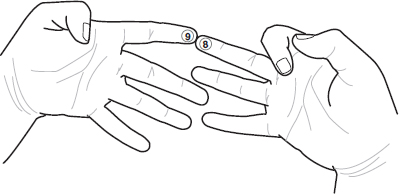
You count the joined fingers and the fingers below the joined fingers to get the first part of your answer. Here, you have a total of seven fingers, so the first digit is 7.
You use the fingers above your joined fingers to find the last digit. On top, you have one finger on the left side and two fingers on the right side. To get the last digit of your answer, you multiply 1 × 2 and get 2.
You then combine 7 and 2, which gives you 72 as your answer.
Let me give you another example to try, 6 × 9. First, join the 6 on your left hand with the 9 on your right hand.
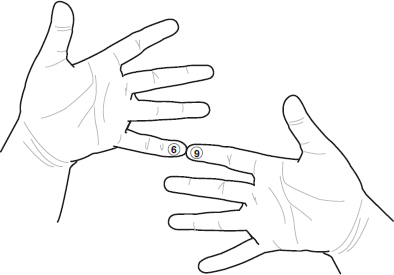
Again, you count the joined fingers and the finger below to get the first part of your answer. Here, it’s 5.
You then count the fingers above the joined fingers on each hand separately and multiply. In this case, you have four fingers on one and one on the other, which multiplied together gives you 4.
After joining the two parts of the answer together, your complete answer becomes 54.
One thing that may come up while doing your universal times tables is carryovers. Let me give you an example to show you how to deal with them.
Say you want to solve 6 × 6. For this problem, both your little fingers are joined.

You get the first part of your answer by counting the joined fingers and any fingers below them. In this case, there are no fingers below, so you just count the fingers to get 2. Note that this 2 is actually two tens or 20.
To get the last part, count the fingers above the joined fingers on each hand. You have four on each hand, so you multiply 4 and 4 to get 16.
To arrive at the final answer, add the two numbers. Adding 20 and 16 gives you a final answer of 36.
You may already know the trick to doing your 9 times table. In case you don’t, though, I’d like to walk you through the easiest way to do them.
Open both your palms in front of you. Starting with your left thumb, count right, mentally numbering each 1 to 10 as you go.
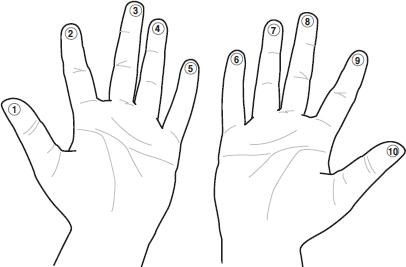
To do the 9 times table, you only need to fold the finger 9 is to be multiplied with. That’s all! Let me give you some examples to illustrate how easy this really is.
To solve 9 × 1, you fold the first finger and count the remaining fingers.
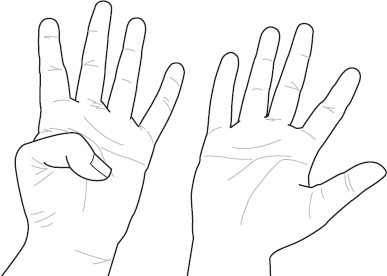
You can see there are nine fingers, so your answer for 9 × 1 is 9.
Let’s take another example, 9 × 3. Begin by folding the third finger on your left hand.
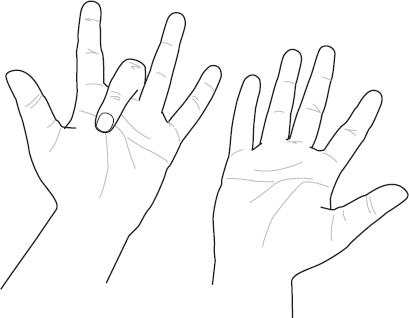
You can see on the left of the folded finger that you have two fingers; on the right of the folded finger, you have seven fingers. Combine 2 and 7 to get your answer, which is 27.
Let’s now solve 9 × 5 on your fingers. Fold the fifth finger. For this one, you can reverse your hands to avoid the discomfort of bending your pinky finger; this way allows you to bend your thumb instead.
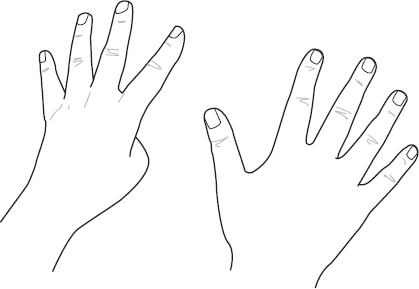
You have four fingers to the left of the folded finger and five fingers to the right of the folded finger. Combined, you get 45 as your answer.
QUICK TIP
If it’s too confusing to change it up, you don’t have to reverse your hands. You’ll still get the same answers—I just like to do it to make the calculations more comfortable.
Special Multiplication by 11
This is a beautiful method that exemplifies what speed math stands for. In a few short steps, you can multiply a number by 11 without reaching for a calculator!
Multiplication of Two-Digit Numbers with 11
To multiply a two-digit number by 11, you split the digits. You then add them to get the middle digit and put everything together to get your answer.
Solve the problem 32 × 11.
Step 1: Split the number you’re multiplying by 11 into two parts, to make it 3 and 2.

Step 2: Add the numbers: 3 + 2 = 5. Place the 5 in between both the numbers and bring the numbers together.

Solution: The answer is 352.
Example 2
Solve the problem 54 × 11.
Step 1: Split 54 into two parts, so 5 becomes the left part and 4 becomes the right part.

Step 2: Add both parts: 5 + 4 = 9. Place the 9 in the middle and combine the numbers together.

Solution: The answer is 594.
Solve the problem 75 × 11.
Step 1: Split 75 into two parts, so 7 goes to the left and 5 to the right.

Step 2: Add the two parts: 7 + 5 = 12. Here, because it’s a double-digit answer, place the 2 in the middle and carry over the 1 to the left side.

Step 3: Add the carryover to the left part: 7 + 1 = 8. Combine all three parts.

Solution: The answer is 825.
Multiplication of Larger Numbers with 11
To multiply larger numbers by 11, you can use a process called adding to the neighbor, which involves adding a digit to the one on its right.
Example 1
Solve the problem 1,234 × 11.
Step 1: Place two lines around the number being multiplied by 11, and add zeroes on the outside of those lines.
Step 2: Now, begin adding numbers to their neighbor. Start with 4; the neighbor of 4 is 0, so add those digits together: 4 + 0 = 4. This is the ones digit of your answer.

Step 3: Add 3 to 4 to get the next digit: 3 + 4 = 7.

Step 4: Add 2 to 3 to get the next digit: 2 + 3 = 5.

Step 5: Add 1 and 2 to get the next digit: 1 + 2 = 3.
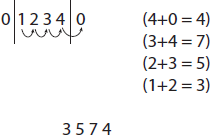
Step 6: Add the 0 with the 1 to get the final digit: 0 + 1 = 1. Combine the numbers.

Solution: The answer is 13,574.
Example 2
Solve the problem 782 × 11.
Step 1: Place two lines around 782, and then add two zeroes on the outside of the lines.

Step 2: Begin adding numbers to their neighbor. Add 2 to 0 to get the ones digit of your answer: 2 + 0 = 2.

Step 3: Add 8 and 2 to get the next digit: 8 + 2 = 10. Because it’s a double digit, place the 0 below and carry over the 1 to the next step.

Step 4: Add 7 to 8 to get your next digit: 7 + 8 = 15. You then add the carryover: 15 + 1 = 16. Place the 6 below and carry over the 1 to the next step.

Step 5: Add 0 and 7 to get your final digit: 7 + 0 = 7. Add the carry over: 7 + 1 = 8. Combine the numbers.

Solution: The answer is 8,602.
SPEED BUMP
While it may seem like two unnecessary steps, don’t skip over adding the first and last numbers to 0 and just put those down as is. Particularly in the case of the last number-and-zero pairing, you may have a carryover from the previous step to include.
Example 3
Solve the problem 5,643 × 11.
Step 1: Place two lines on either side of 5,643 and then add two zeroes outside the lines.
Step 2: Add neighbors 3 and 0 to get the ones digit: 3 + 0 = 3.

Step 3: Add 4 and 3 to get the next digit: 4 + 3 = 7.

Step 4: Add 6 and 4 to get the next digit: 6 + 4 =10. Because it’s a double digit, place the 0 below and carry over the 1 to the next step.

Step 5: Add 5 and 6 to get the next digit: 5 + 6 = 11. Add the carry over from the previous step: 11 + 1 = 12. Place the 2 below and carry over the 1 to the next step.

Step 6: Add 0 to 5 to get the final digit: 5 + 0 = 5. Add the carryover: 5 + 1 = 6. Combine the numbers.

Solution: The answer is 62,073.
Below the Base Method
The base method of speed multiplication is one of the quickest ways to multiply numbers near a base, such as 10 or 100. This method of speed multiplication is perhaps one of the most fascinating and jaw-dropping methods of mental calculation you will ever come across. Through this method, I’ll show you that solving small or large multiplication problems doesn’t need to be complicated or cumbersome—rather, it can be simple and easy!
There are two important rules to remember while implementing the base method:
- Add or subtract crosswise.
- Multiply vertically.
QUICK TIP
This method is used to multiply numbers that are close to powers of 10, which are also called bases. For example, 10 and 100 are bases.
I’ll begin with some examples of problems with numbers below the base.
Below Base 10
I know you must be thinking, I already know how to do multiplication problems with numbers under 10; why do I need to use this method to solve it? I first want to help you build a solid foundation by solving simple sums near to the base 10 before moving on to higher bases.
Example 1
Solve the problem 8 × 7.
Step 1: Figure out how much below 10 each number is. The 8 is 2 less than 10, and the 7 is 3 less than 10; place 2 and 3 to the right. Because both numbers are less than 10, place a minus sign next to them.

Step 2: To get the first digit of your answer, subtract crosswise. You can choose either 8 − 3 and 7 − 2, both of which give you 5.

Step 3: To get the last digit of your answer, multiply vertically. Here, you multiply −3 × −2, which gives you +6. Bring the two digits together.

Solution: The answer is 56.
Example 2
Solve the problem 9 × 7.
Step 1: The numbers 9 and 7 are both near base 10; 9 is 1 less than 10, and 7 is 3 less than 10, so put 1 and 3 on the right. Because both numbers are less than base 10, place a minus sign next to them.

Step 2: Subtract crosswise. You can choose either 9 − 3 or 7 − 1, both of which give you 6. The 6 is the first digit of your answer.

Step 3: To get the last digit of your answer, multiply vertically. Here, you multiply −1 × −3, which gives you +3. Bring the two digits together.

Solution: The answer is 63.
QUICK TIP
At this point, I want to introduce another basic rule of the base method. Because base 10 has one zero, there will only be one digit on the right side. If the base is 100, there will be two digits on the right side, for base 1,000 there will be three digits on the right side, and so on.
Example 3
Solve the problem 8 × 4.
Step 1: Find the difference of 8 and 4 from 10. Because 8 is less than 10 by 2, put −2 on the right. Because 4 is 6 less than 10, put −6 on the right.

Step 2: To get the first digit of your answer, subtract crosswise. You can choose either 8 − 6 or 4 − 2, both of which give you 2.

Step 3: To arrive at the second digit of your answer, multiply vertically: −2 × −6 = +12. Because you can’t have a double-digit answer on the right, bring down the 2 and carry over the 1 to the left. Add the 1 to the 2 on the left: 1 + 2 = 3. Bring the two digits together.

Solution: The answer is 32.
For math problems near base 100, you’ll have two digits on the right to account for the two zeroes in 100.
Example 1
Solve the problem 99 × 97.
Step 1: Because 99 and 97 are both near 100, that becomes the base. Like you did for the base 10 problems, find the difference for 99 and 97 from 100. 99 is less than 100 by 1 and 97 is less than 100 by 3. Again, these should be negative, as they’re both below the base. Also, because 100 has two zeroes, you need to put two digits on the right. In this case, you add a zero before each digit to make them −01 and −03.

Step 2: Subtract crosswise to get the first part of your answer. You can do 99 − 03 or 97 − 01, both of which give you 96.

Step 3: To arrive at the final part of your answer, multiply vertically: −01 × −03 = +03. Bring the two parts together.

Solution: The answer is 9,603.
Solve the problem 98 × 97.
Step 1: Subtract the numbers from 100. In this case, 98 is less than 100 by 2, so put −02 on the right; 97 is less than 100 by 3, so put −03 on the right.

Step 2: Subtract crosswise to get the first part of your answer. You can do either 98 − 03 or 97 − 02, both of which give you 95.

Step 3: To get the second part of your answer, multiply vertically: −02 × −03 = +06. Bring the two parts together.

Solution: The answer is 9,506.
Example 3
Solve the problem 88 × 88.
Step 1: Subtract from base 100. In this case, 88 is less than 100 by 12, so put down −12 on the right for both.

Step 2: Cross-subtract to get the first part of the answer. Both are exactly the same, so do 88 − 12, which gives you 76.

Step 3: Multiply vertically to get the second part of your answer: −12 × −12 = +144. Because 144 is a three-digit number, put down 44 with 1 as the carryover.

Step 4: Carry the 1 to the left side and add it to 76: 76 + 1 = 77. Bring the two parts together.
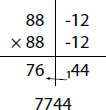
Solution: The answer is 7,744.
Above the Base Method
Now that you know how to solve problems with numbers below the base, let’s try some problems in which the numbers are just above the base.
Above Base 10
For numbers in excess of base 10, instead of having a minus sign and subtracting the difference from 10, you have positive numbers which are added crosswise to get the first part of your answer.
Solve the problem 11 × 12.
Step 1: Find the difference between the numbers and base 10. In this case, 11 is 1 more and 12 is 2 more than base 10. Write those numbers on the right, with a plus sign next to them.

Step 2: Add crosswise to get the first part of the answer. You can do either 11 + 2 or 12 + 1, both of which give you 13.

Step 3: Multiply vertically to get the second part of the answer: +1 × +2 = 2. Combine the two parts.

Solution: The answer is 132.
QUICK TIP
Remember, you can do either addition problem when cross-adding; both should give you the same answer.
Solve the problem 12 × 13.
Step 1: Find the difference between the numbers and base 10. In this case, 12 is more than 10 by 2 and 13 is more than 10 by 3, so put +2 and +3 on the right.

Step 2: Cross-add to get the first part of the answer. You can do either 12 + 3 or 13 + 2, both of which give you 15.

Step 3: To arrive at the second part of the answer, multiply vertically: +2 × +3 = +6. Combine the two parts.

Solution: The answer is 156.
Solve the problem 15 × 16.
Step 1: Find the difference between the numbers and base 10. In this case, 15 is more than 10 by 5 and 16 is more than 10 by 6, so put +5 and +6 on the right.

Step 2: Add crosswise to get the first part of the answer. You can do 15 + 6 or 16 + 5, both of which give you 21.

Step 3: Multiply vertically to get the second part of the answer: +5 × +6 = +30. Because you get a two-digit number, put down the 0 and carry over the 3 to the left. Add the carryover: 21 + 3 = 24. Combine the two parts.

Solution: The answer is 240.
Above Base 100
Let’s now take a look at some problems with numbers above base 100 and see how to solve them using the base method.
Example 1
Solve the problem 104 × 107.
Step 1: Find the difference between the numbers and 100. In this case, 104 is 4 more than 100, and 107 is 7 more than 100. Because there are two zeroes in 100, the numbers on the right have to be two digits; therefore, you put +04 and +07 on the right.

Step 2: Add crosswise to get the first part of the answer. You can do either 104 + 07 or 107 + 04, both of which add to 111.

Step 3: To get the second part of the answer, multiply vertically: +04 × +07 = +28. Bring together the two parts.

Solution: The answer is 11,128.
QUICK TIP
Remember, in problems where the base is 100, there will be two digits on the right side. Any extra digit will be carried over to the left.
Solve the problem 105 × 109.
QUICK TIP
For this example, I would like you to visualize the problem in your head and see if you can do it mentally. The answer is 11,445.
Step 1: Find the difference between the numbers and 100. In this case, 105 is 5 more and 107 is 7 more than 100, so put +05 and +07 on the right.

Step 2: Add crosswise to get the first part of the answer. You can do 105 + 09 or 109 + 05, both of which equal 114.

Step 3: To arrive at the second part of the answer, multiply vertically: +05 × +09 = +45. Combine the two parts.

Solution: The answer is 11,445.
Example 3
Solve the problem 112 × 112.
Step 1: Find the difference between the numbers and 100. In this case, 112 is more than 100 by 12, so put +12 for both numbers on the right.

Step 2: Add crosswise to get the first part of the answer. Because both addition problems are the same, you simply add 112 and 12, which gives you 124.

Step 3: To get the second part of the answer, multiply vertically: +12 × +12 = 144. Because it’s a three-digit number, put down the 44 and carry over the 1 to the left. Add the carryover to 124: 124 + 1 = 125. Combine the two parts.
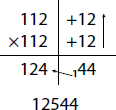
Solution: The answer is 12,544.
Above and Below the Base Method
You’ve seen that numbers can be below the base or above the base. But sometimes, you’ll multiply numbers in which one is below the base and the other is above the base. What should you do in such cases? The following takes you through how to solve them depending on the base.
Above and Below Base 10
When you have one number above base 10 and one below base 10, you’ll be dealing with a negative number. To get rid of it, you multiply the left side by 10 and subtract the right side from it.
Example 1
Solve the problem 11 × 9.
Step 1: Find the difference between the numbers and 10. In this case, 11 is 1 more than 10, so put down +1 on the right; 9 is 1 less than 10, so put −1 on the right.

Step 2: Add or subtract crosswise to get the first part of your answer. You can do 11 − 1 or 9 + 1, both of which equal 10. Next, multiply vertically to get the second part: +1 × −1 = −1.

Step 3: Because your answer can’t be negative, you multiply the left side by 10, which is the base: 10 × 10 = 100. You then subtract the left side from the right side.
Solution: The answer is 99.
QUICK TIP
You may be wondering, Why do I have to do a simple problem like 11 × 9 this way? These examples are simply building the foundation to deal with larger numbers. When the larger numbers come, you’ll be able to deal with them smoothly.
Example 2
Solve the problem 14 × 8.
Step 1: Find the difference between the numbers and 10. In this case, 14 is 4 more than 10, so you put +4 on the right; 8 is 2 less than 10, so put −2 on the right.

Step 2: Add or subtract crosswise to get the first part of your answer. You can do 14 − 2 or 8 + 4, both of which give you 12. To get the second part of the answer, multiply vertically: +4 × −2 = −8.

Step 3: Your base is 10, so multiply the left side by 10: 12 × 10 = 120. Subtract the left side from the right side.
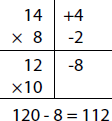
Solution: The answer is 112.
Example 3
Solve the problem 17 × 8.
Step 1: Find the difference between the numbers and 10. In this case, 17 is 7 more than 10, so put +7 on the right; 8 is 2 less than 10, so put −2 on the right.

Step 2: Add or subtract crosswise to get the first part of the answer. You can do 17 − 2 or 8 + 7, both of which equal 15. Multiply vertically to get the second part: +7 × −2 = −14.

Step 3: Because the base is 10, multiply the left side by 10: 15 × 10 = 150. Subtract the left side from the right side.
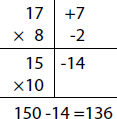
Solution: The answer is 136.
The process for solving multiplication problems with numbers above and below base 100 is pretty much the same as what you did for base 10. The only difference is that you multiply by 100 instead of 10.
Example 1
Solve the problem 106 × 92.
Step 1: Find the difference between the numbers and 100. For 106, the excess is 6 and for 92, the deficiency is 8. Therefore, put down +6 and −8 on the right.

Step 2: Add or subtract crosswise to get the first part of the answer. You can do 106 − 8 or 92 + 6, both of which equal 98. So 98 is our first part. Multiply vertically to get the second part: 6 × −8 = −48.

Step 3: Multiply the left side by 100: 98 × 100 = 9,800. Subtract the left side from the right side.
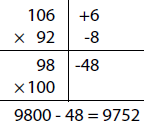
Solution: The answer is 9,752.
Solve the problem 105 × 88.
Step 1: Find the difference between the numbers and 100. In this case, 105 is in excess 100 by 5, so put +5 on the right; 88 is below hundred by 12, so put −12 on the right.

Step 2: Add or subtract crosswise to get the first part of the answer. You can do 105 − 12 or 88 + 5, both of which give you 93. Multiply vertically to get the second part: +5 × −12 = −60.

Step 3: Multiply the left hand side by 100: 93 × 100 = 9,300. Subtract the left side from the right side.
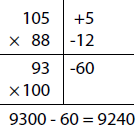
Solution: The answer is 9,240.
Solve the problem 117 × 91.
Step 1: Find the difference between the numbers and 100. In this case, 117 is 17 more than 100, so put +17 on the right; 91 is 9 less than 100, so put −9 on the right.

Step 2: Add or subtract crosswise to get the first part of the answer. You can do 117 − 9 or 91 + 17, both of which equal 108. Multiply vertically to get the second part: +17 × −9 = −153.

Step 3: Multiply the left side by base 100: 108 × 100 = 10,800. Subtract the left side from the right side.
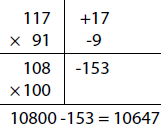
Solution: The answer is 10,647.
Multiples and Submultiples
If you have to multiply numbers that are both far lower or far higher than the base, you can use a base that’s a multiple of 10. The following give you some examples of this.
Example 1
Solve the problem 46 × 48.
Step 1: For 46 and 48, instead of using base 100, make the base 50 and find the difference. This gives you −4 and −2, which you put on the right side.

Step 2: Cross-subtract to get the first part of your answer. You can do 46 − 2 or 48 − 4, both of which equal 44. Multiply vertically to get the second part of your answer: −4 × −2 = +8.

Step 3: Because the base is 50, which you get by multiplying 10 × 5, multiply the left side by 5: 44 × 5 = 220. Bring the two parts together.

Solution: The answer is 2,208.
Solve the problem 59 × 59.
Step 1: Here, the base could be 50 or 60. However, because both numbers are closer to 60, go ahead and use 60 as the base. Find the difference between the numbers and 60. Both are 1 less than 60, so put −1 on the right.

Step 2: Subtract crosswise for the first part of the answer. Both are 59 − 1, which equals 58. Multiply vertically to get the second part of the answer: −1 × −1 = 1.

Step 3: Because the base is 60, multiply the left side by 6: 58 × 6 = 348. Bring the two parts together.

Solution: The answer is 3,481.
Solve the problem 216 × 204.
Step 1: Both are close to 200, so make 200 the base and find the difference. Because 216 is 16 more and 204 is 4 more than 200, put +16 and +04 on the right.

Step 2: Add crosswise to get the first part of the answer. You can do 216 + 04 or 204 + 16, both of which equal 220. Multiply vertically to get the second part: +16 × +04 = +64.

Step 3: Because 100 × 2 = 200, multiply the left side by 2: 220 × 2 = 440. Bring the two parts together.
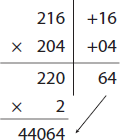
Solution: The answer is 44,064.
SPEED BUMP
Don’t multiply the left side by the actual base number. Instead, use the number you have to multiply with to get to base 10 or base 100. For example, if your base is 300, you don’t multiply the left by 300; instead, you multiply by 3, because the base is 100 × 3.
If you have a problem in which one number is far below the base, and the other is far above it, you can use a multiple of 10 as the base. As you’ll see in the following examples, this process mimics the above and below the base method.
Example 1
Solve the problem 199 × 202.
Step 1: Make the base 200 for these numbers and find the difference. Because 199 is 1 less and 202 is 2 more than 200, put −01 and +02 on the right.

Step 2: Add or subtract crosswise to get the left side. You can do 199 + 02 or 202 − 01, both of which equal 201. Multiply vertically to get the right side: +02 × −01 = −02.

Step 3: Because the base is 200, multiply the left side by 2: 201 × 2 = 402. Multiply 402 by 100: 402 × 100 = 40,200.
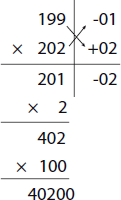
Step 4: Subtract the right side from the left side.

Solution: The answer is 40,198.
Example 2
Solve the problem 297 × 304.
Step 1: Make the base 300 and find the difference. In this case, 297 is 3 less and 304 is 4 more than 300, so put −03 +04 on the right side.

Step 2: Add or subtract crosswise for the left side. You can do 297 + 04 or 304 − 03, both of which equal 301. Multiply vertically for the right side: +04 × −03 = −12.

Step 3: Because the base is 300, multiply the left side by 3: 301 × 3 = 903. Multiply 903 by 100: 903 × 100 = 90,300.
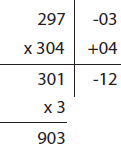
Step 4: Subtract the right side from the left side.
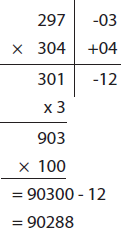
Solution: The answer is 90,288.
SPEED BUMP
Unlike in earlier problems involving the base method, simply combining the two parts of the answer won’t yield the correct response. You have to subtract the right side from the left side to get your answer.
General Multiplication Using the Vertically and Crosswise Method
The base method is great if both numbers are close to the same base, but you’ll encounter many problems in which the numbers aren’t even remotely close to each other. Enter the vertically and crosswise method.
As the name indicates, the vertically and crosswise method uses a vertical and crosswise pattern to multiply numbers. This method is extremely versatile, with varied applications (as you’ll see throughout the book).
Two-Digit by Two-Digit Multiplication
To solve any problems in which a two-digit number is multiplied by a two-digit number, use the following version of the vertically and crosswise method.

You multiply vertically, then crosswise, and vertically again. The following examples show you how to apply this method.
Example 1
Solve the problem 12 × 43.
Step 1: To get the first digit of your answer, multiply vertically on the right side: 3 × 2 = 6.

Step 2: To get the next digit, multiply crosswise and add: (3 × 1) + (4 × 2) = 3 + 8 = 11. Put down 1 as the tens-place digit and carry over the 1 to the next step.

Step 3: To get the last digit, multiply vertically on the left side: 4 × 1 = 4. Add the carryover: 4 + 1 = 5.

Solution: The answer is 516.
Example 2
Solve the problem 78 × 69.
Step 1: Multiply vertically on the right: 9 × 8 = 72. Put down 2 and carry over the 7 to the next step.

Step 2: Multiply crosswise and add; include the carryover 7 in the addition: (9 × 7) + (6 × 8) + 7 = 63 + 48 + 7 = 118. Put down 8 in the tens place and carry over the 11 to the next step.

Step 3: Multiply vertically on the right and add the carryover: (6 × 7) + 11 = 42 + 11 = 53.

Solution: The answer is 5,382.
QUICK TIP
The examples have shown how to do the vertically and crosswise method from right to left, but you can also do it from left to right. If you have any carryovers, you add them to the previous step rather than the next step.
Example 3
Solve the problem 34 × 8.
Step 1: Because 8 isn’t a two-digit number, put a zero before the 8 before starting the method.
Step 2: Multiply vertically on the right: 8 × 4 = 32. Put down the 2 and carryover the 3 to the next step.

Step 3: Multiply crosswise and add; don’t forget to include the carryover 3 in the addition: (8 × 3) + (4 × 0) + 7 = 24 + 0 + 3 = 27. Put 7 down in the tens place and carry over the 2 to the next step.

Step 4: Multiply vertically on the right side and add the carryover: (0 × 3) + 2 = 0 + 2 = 2.

Solution: The answer is 272.
Three-Digit by Three-Digit Multiplication
This is an extension of the two-digit version of the vertically and crosswise method. The three-digit version of the method involves five simple steps.

Think of the steps as vertical, crosswise, star, crosswise, and vertical. The following examples take you through the process for multiplying a three-digit number by another three-digit number.
Example 1
Solve the problem 123 × 456.
Step 1: Multiply vertically on the right side: 6 × 3 = 18. Put 8 down in the units place figure and carry over the 1 to the next step.

Step 2: Multiply the right and middle columns crosswise and add; don’t forget to include the carryover in the addition: (6 × 2) + (5 × 3) + 1 = 12 + 15 + 1 = 28. Put 8 down in the tens place and carry over the 2 to the next step.

Step 3: Multiply in the star pattern—the bottom-right and top-left numbers, the top and bottom middle numbers, and the bottom-left and top-right numbers—and add; don’t forget to include the carryover in the addition: (6 × 1) + (4 × 3) + (5 × 2) + 2 = 6 + 12 + 10 + 2 = 30. Put down 0 and carry over the 3 to the next step.

Step 4: Multiply the left and middle columns crosswise and add; don’t forget to include the carryover in the addition: (5 × 1) + (4 × 2) + 3 = 5 + 8 + 3 = 16. Put down 6 and carry over the 1 to the next step.

Step 5: Multiply vertically on the left side: 4 × 1 = 4. Add the carryover: 4 + 1 = 5.

Solution: The answer is 56,088.
Solve the problem 231 × 745.
Step 1: Multiply vertically on the right side: 5 × 1 = 5.

Step 2: Multiply the right and middle columns crosswise and add: (5 × 3) + (4 × 1) = 15 + 4 = 19. Put down 9 in the tens place and carry over the 1 to the next step.

Step 3: Multiply in the star pattern—the bottom-right and top-left numbers, the top and bottom middle numbers, and the bottom-left and top-right numbers—and add; don’t forget to include the carryover in the addition: (5 × 2) + (7 × 1) + (4 × 3) + 1 = 10 + 7 + 12 + 1 = 30. Put 0 down and carry over the 3 to the next step.

Step 4: Multiply the left and middle columns crosswise and add; don’t forget to include the carryover in the addition: (4 × 2) + (7 × 3) + 3 = 8 + 21 + 3 = 32. Put down 2 in the thousands place and carry over the 3 to the next step.

Step 5: Multiply vertically on the left side: 7 × 2 = 14. Add the carryover: 14 + 3 = 17.

Solution: The answer is 172,095.
QUICK TIP
Take some time to learn the star in particular in the three-digit version. In the beginning, you may make some errors here and there, but ultimately I’m sure you’ll increase your speed and accuracy in solving three-digit multiplication problems.
Example 3
Solve the problem 321 × 042.
Step 1: Multiply vertically on the right side: 2 × 1 = 2. Put 2 down in the units place.

Step 2: Multiply the right and middle columns crosswise and add: (2 × 2) + (4 × 1) = 4 + 4 = 8. Put down 8 in the tens place.

Step 3: Multiply in the star pattern—the bottom-right and top-left numbers, the top and bottom middle numbers, and the bottom-left and top-right numbers—and add: (2 × 3) + (0 × 1) + (4 × 2) = 6 + 0 + 8 = 14. Put 4 in the thousands place and carry over the 1 to the next step.
Step 4: Multiply the left and middle columns crosswise and add; don’t forget to include the carryover in the addition: (4 × 3) + (0 × 2) + 1 = 12 + 0 + 1 = 13. Put down 3 in the thousands place and carry over the 1 to the next step.

Step 5: Multiply vertically on the left side: 0 × 3 = 0. Add the carryover: 0 + 1 = 1.

Solution: The answer is 13,482.
The Least You Need to Know
- You can use your fingers to do your times tables, whether it’s by counting the joints of the fingers or joining two and counting the digits above and below them.
- When multiplying a two-digit number by 11, split the two digits and add to get the middle digit.
- If your number is near a base, you can round to the base to help you find the answer.
- Depending on how many digits they have, you can use a vertical and crosswise pattern to multiply two numbers.

